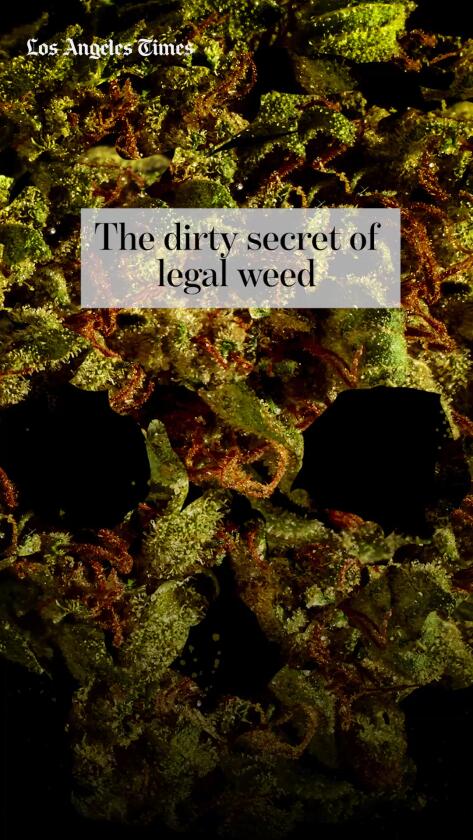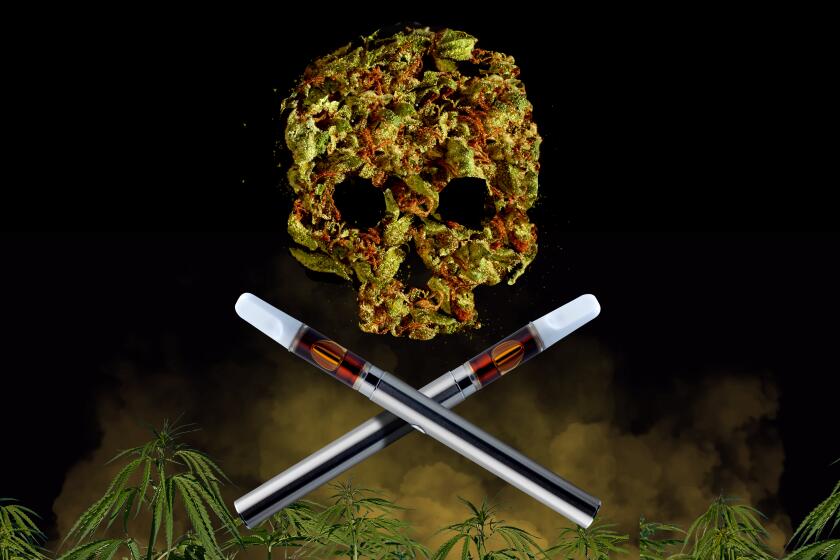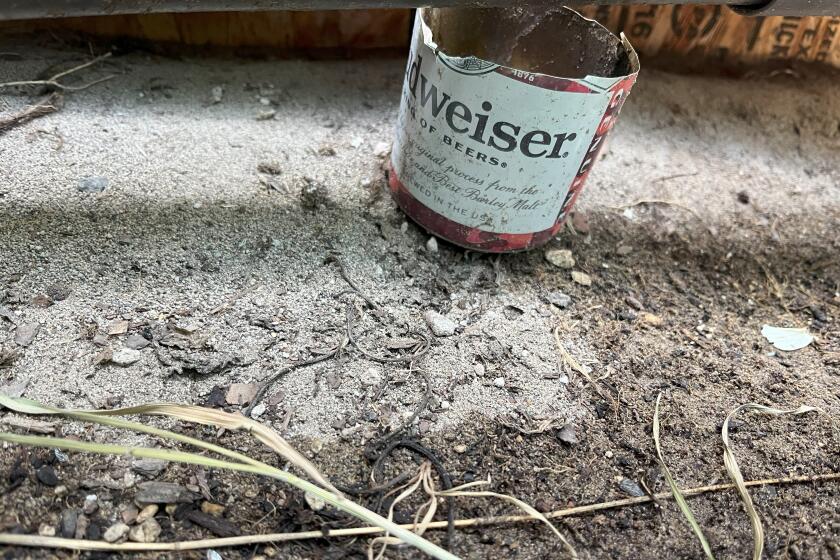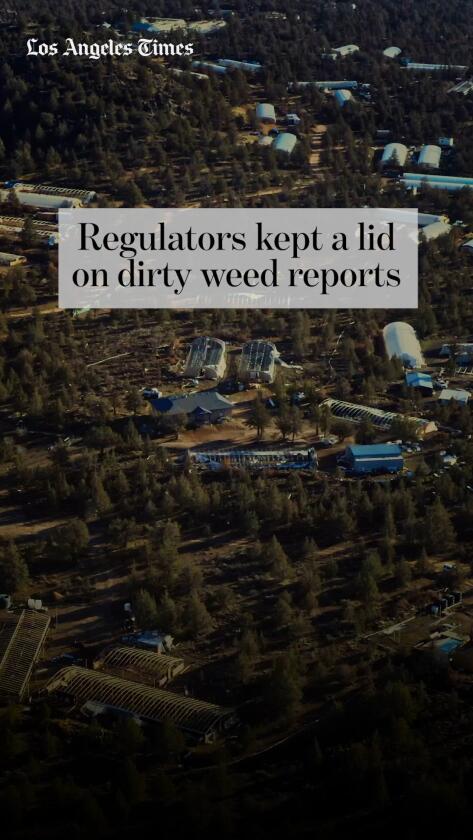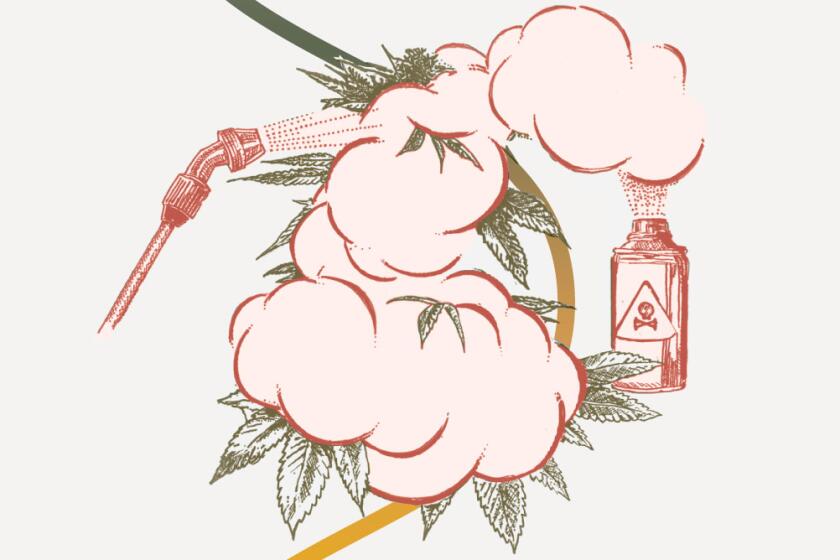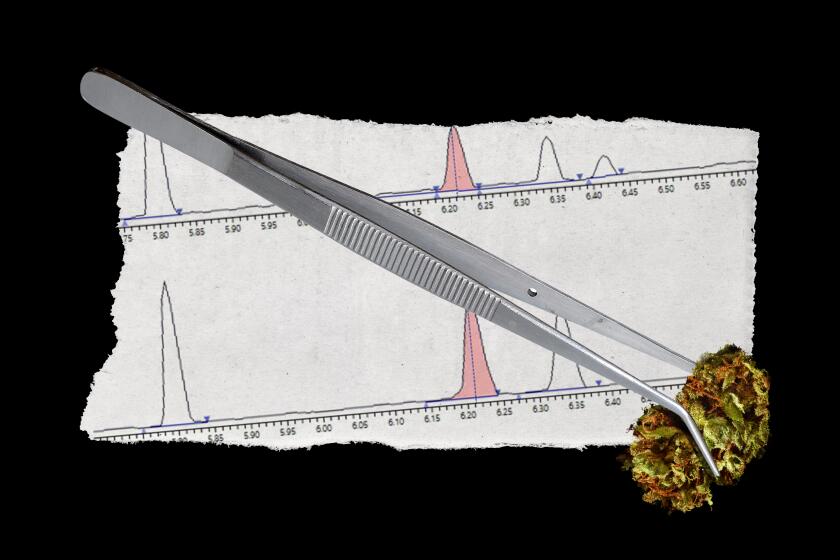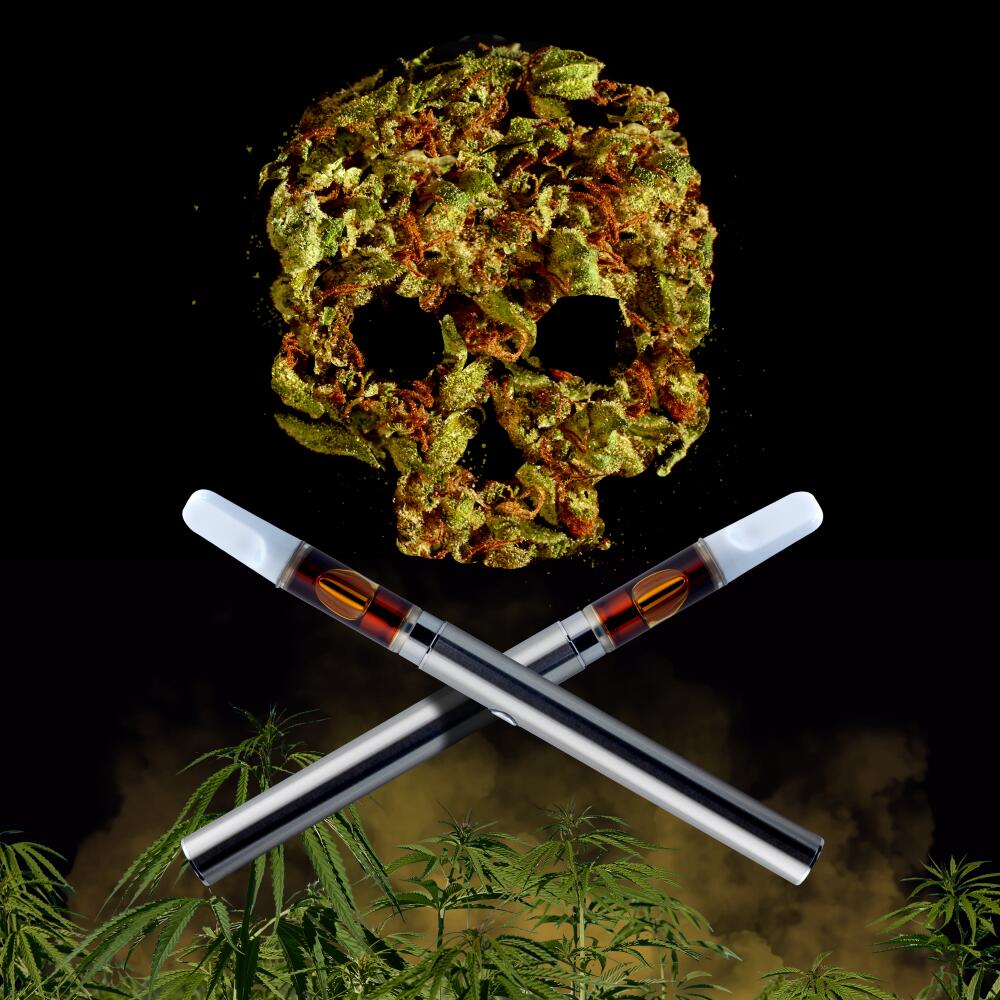
- Share via
Aging yuppies in neon beachwear stand before a green wall with the catchphrase “You have changed ... so has cannabis.”
The social media post is part of “Real CA Cannabis,” a $5-million taxpayer-funded campaign to promote California cannabis as safe, tested and “regulated by the state to protect consumers.”
In reality, that safety is far from certain.
An investigation by The Times, in conjunction with cannabis industry newsletter WeedWeek, found alarming levels of pesticides in cannabis products available on dispensary shelves across the state, including some of the most popular brands of vapes and pre-rolled weed.
Twenty-five of 42 legal cannabis products that The Times and WeedWeek purchased from retail stores and had tested at private labs showed concentrations of pesticides either above levels the state allows or at levels that exceed federal standards for tobacco. The contaminants include chemicals tied to cancer, liver failure, thyroid disease and genetic and neurologic harm to users and unborn children.
Most of the pesticides found were in low concentrations that risk long-term harm by repeated use, though the extent of the health threat may not be known for years.
Vapes tested from five well-known brands had pesticide loads that exceeded federal Environmental Protection Agency risk thresholds for harm from a single exposure, The Times and WeedWeek found. Users might experience irritation to the lungs, eyes and throat as well as rash, headache, diarrhea and abdominal pain.
Some individual products contained as many as two dozen pesticides.
The findings dovetail with scores of complaints that two private cannabis testing labs have filed over the last eight months, reporting pesticides in products certified by other labs as safe. The results, the labs said, suggest some level of contamination in more than 250,000 vapes and pre-rolled joints on store shelves, about the number sold legally in California in a two-day period.
There are strong profit incentives driving contamination. Expanding legal markets encourage intensive growing practices to increase yield, inviting the use of pesticides to protect those high-value crops from insect infestations common in greenhouse environments.
At the same time, the soaring popularity of vapes has created heavy demand for bulk oils, which are made from lower-quality cannabis, often grown illegally.
Reviews of confidential lab reports, public records and interviews show California regulators have largely failed to address evidence of widespread contamination in the state’s weed crop.
The state’s requirements for weed testing also have not been updated to include dangerous chemicals currently used in cultivation, including illegal, smuggled pesticides so toxic that law enforcement officers who encounter them are advised to don respirators and take blood poisoning tests.
- Share via
The health stakes from contaminated weed are high.
An estimated 5 million Californians consume cannabis products in any given month, according to the most recent federal health surveys. The presence of pesticides is particularly fraught for those who turn to weed for relief from medical conditions — conditions that put them at increased risk of harm.
Long-term public health concerns are exacerbated by the growing use of vapes, which contain the greatest contamination levels and are marketed to young adults who are more apt to consider vaping a healthful alternative to tobacco or alcohol.
California Department of Cannabis Control officials declined to make anyone available for an interview. The agency also would not release either external or internal discussions of pesticide contamination, and refused to release information on its ability to test cannabis products, saying such knowledge would encourage bad actors.
A Los Angeles Times investigation, in conjunction with WeedWeek, finds alarming levels of pesticides in cannabis products at dispensaries across the state.
It would not furnish the results of pesticide tests it had received from other state agencies and would not provide the safety certificates for cannabis products on the market. It also declined to say what action it has taken on at least 85 contamination complaints it has received since last fall from private labs, or disclose what tainted products it pulled from sale.
“When we receive complaints, we swiftly assess them, conduct appropriate investigations, and take appropriate action,” the agency’s press office said by email.
The agency is now scrambling to initiate California’s first market tests for pesticides, sending a recent email warning license holders of coming “product embargos, voluntary and mandatory recalls, and disciplinary actions.” The private labs that raised alarms for many months questioned why authorities did not act sooner.
California cannabis regulators initially responded to those complaints with a single product recall, and in orders that remain confidential, required three other products be removed from store shelves.
Frustrated that more was not done, Josh Swider, the chief executive of Infinite Chemical Analysis Labs and author of most of the complaints, in December sent his summary of contaminated products directly to Gov. Gavin Newsom and cannabis regulators in an email. “Those failing products alone represented 150,000 packages of flower, vapes or pre-rolls for sale to unsuspecting consumers,” he wrote.
“The government’s responsibility does not end after writing regulation.”
After Swider sent his letter, an additional product was recalled for pesticide contamination. The remaining tainted batches were left to sell out.
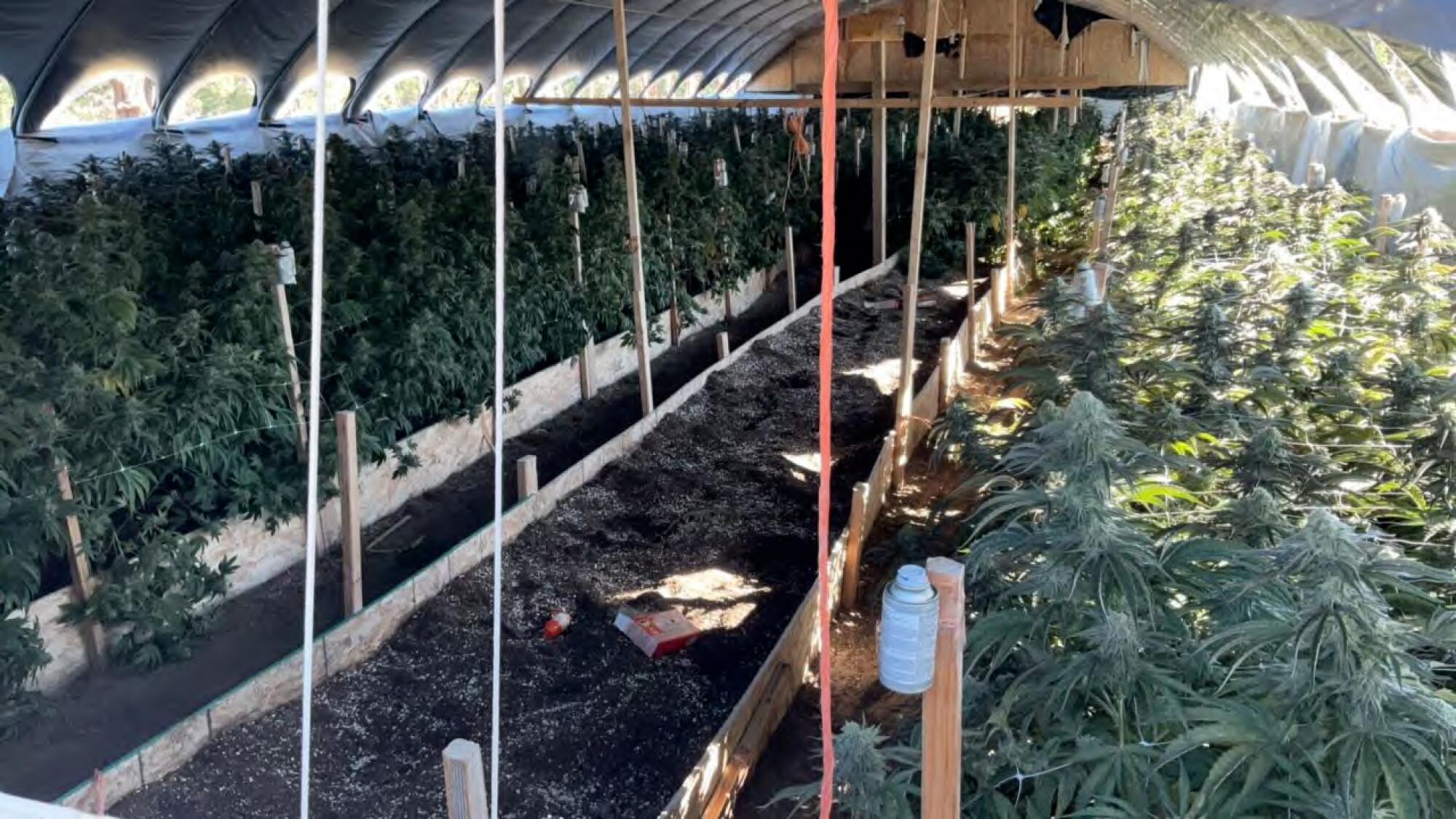

California’s legalization of recreational cannabis in 2016 ushered in a multibillion-dollar industry estimated to be the largest legal weed market in the world. But many of the promises of legalization have proved elusive. In a series of occasional stories, we’ll explore the fallout of legal weed in California.
Meanwhile, licensing files show the state’s seed-to-sale inventory system contains faulty data, including missing crops, misidentified products and safety tests that don’t match the goods sold. Testing is done by state-approved independent labs, but no state-run lab is accredited to test for pesticides. There is no routine testing for the chemicals in products on store shelves, putting California out of sync with “best practices” adopted by the Cannabis Regulators Assn.
Those gaps leave policing of the industry largely in the hands of labs financially beholden to the companies whose products they test. Legislation to require independent fraud and accuracy checks has remained stalled in Sacramento for two years amid backroom negotiations between industry players and regulators.
“California is dropping the ball on enforcement where public health is concerned,” said cannabis researcher Cindy Orser, a former director of a private California cannabis testing lab.
Testing for harmful chemicals
California requires cannabis products to be tested for 66 pesticides. That list, unchanged since 2018, has not kept pace with current cultivation practices.
Tests conducted for The Times and WeedWeek identified seven off-list pesticides in legal products on store shelves. One brand of vape contained fenvalerate, a fungicide proven to lower sperm counts and prohibited in the United States since 2008. Sixteen products contained pymetrozine, an insecticide known to cause liver cancer and to mimic human hormones, part of a chemical class known as endocrine disruptors, which over time cause reproductive disorders. Pymetrozine is approved for only limited use by the federal EPA, and is banned in the U.K., Canada and Norway.
For the record:
4:56 p.m. Nov. 15, 2024This article states that a “pink acai vape from Stiiizy, the state’s top selling cannabis brand, carried more than 60 times the maximum amount of pymetrozine allowed by federal regulators in cigarettes.” Federal regulators do not have a maximum residue level for pymetrozine on tobacco. However, the Environmental Protection Agency requires pesticide residue to be below 0.1 ppm before approving a product for use on tobacco crops. Residue above that amount requires additional study of human health impacts. California prohibits the use of pymetrozine on cannabis, but the state does not require that cannabis products be tested for the chemical. Tests conducted for the Los Angeles Times found that Stiiizy’s vape carried more than 60 times the 0.1 ppm federal threshold that applies to tobacco. Elsewhere, the story incorrectly states that the EPA threshold is 0.01 ppm.
A pink acai vape from Stiiizy, the state’s top-selling cannabis brand, carried more than 60 times the maximum amount of pymetrozine allowed by federal regulators in cigarettes. But because California does not require testing for pymetrozine, the company that makes Stiiizy products said it is not in violation of state regulation.
“We adhere to all standards and limits set by the State of California, which has some of the strictest testing requirements and pesticide limits in the country,” Stiiizy President Tak Sato said in an email.
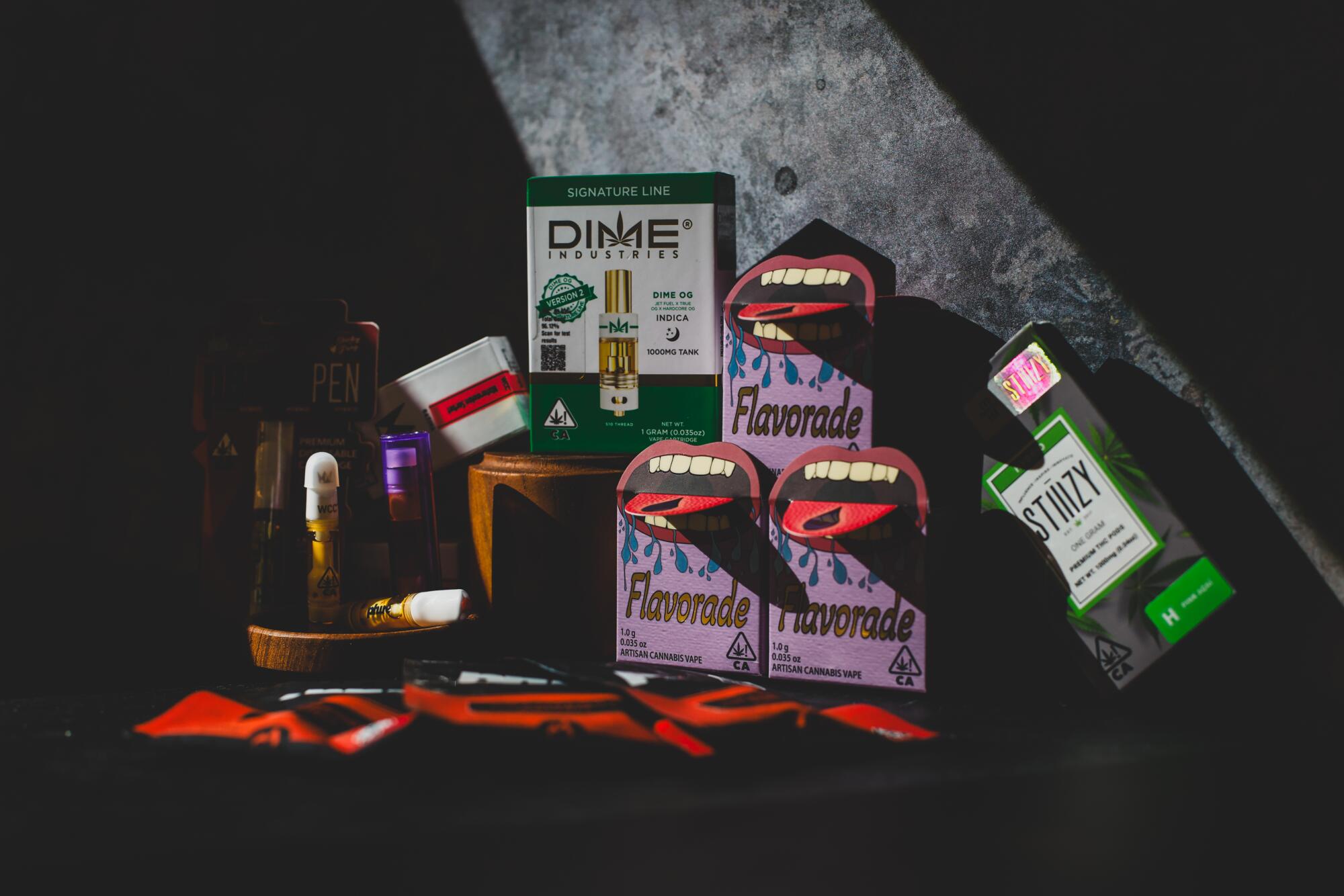
The Times and WeedWeek testing also found another off-list chemical, propargite, a carcinogenic insecticide that UCLA researchers have linked to brain-cell death and increased incidence of Parkinson’s disease in Central Valley residents. It showed up in some vapes at nearly three times what is permitted in cigarettes.
Slipping into the legal supply
The state’s unlicensed cannabis operations remain a primary source of concern. Deadly carbofuran and methamidophos, banned insecticides usually smuggled from Mexico, continue to appear across California, according to state Department of Fish and Wildlife, regional water board and county investigative records. On a Trinity County farm in 2023, an environmental health report shows, officers found a 3-pound tin of Fumitoxin, a poison that emits phosgene gas, along with evidence workers there were suffering severe diarrhea from exposure.
The chemicals occasionally turn up in the legal market. One, methamidophos, was detected in January in dried cannabis at a Van Nuys manufacturer, along with evidence the company was shipping the product across the country. Its license was revoked.
1
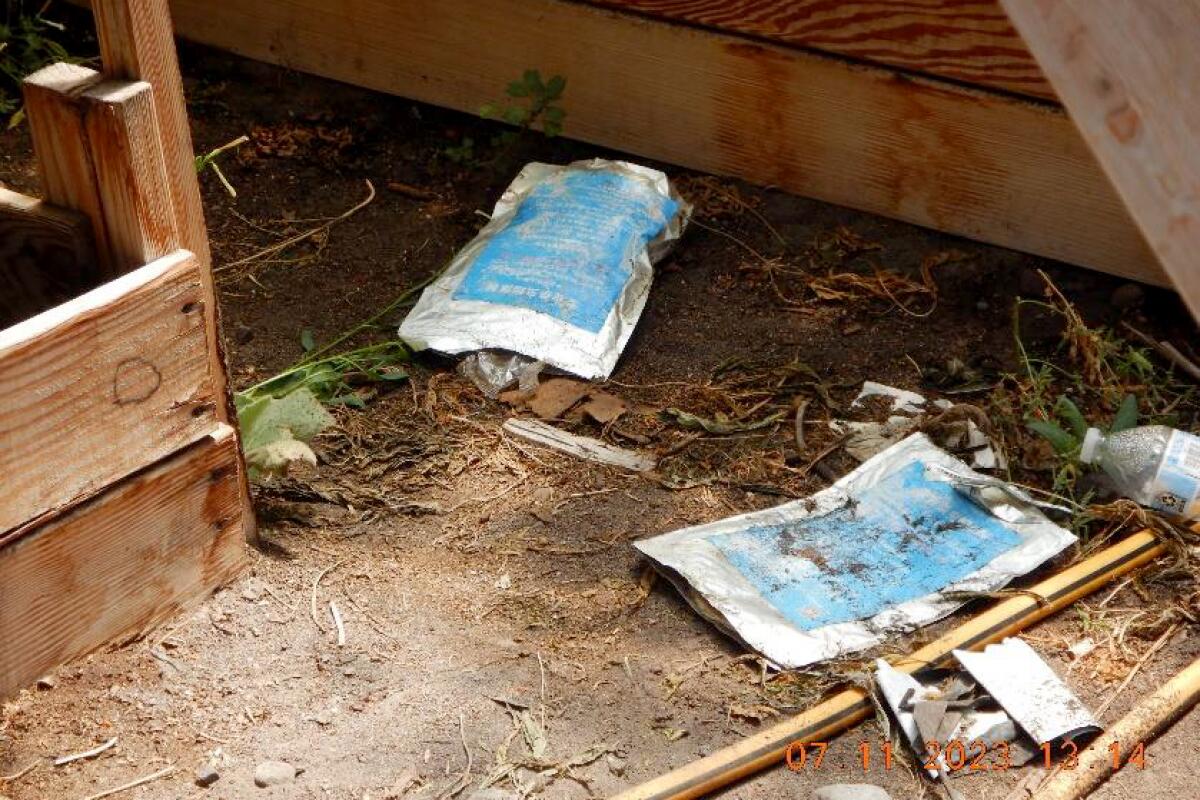
2
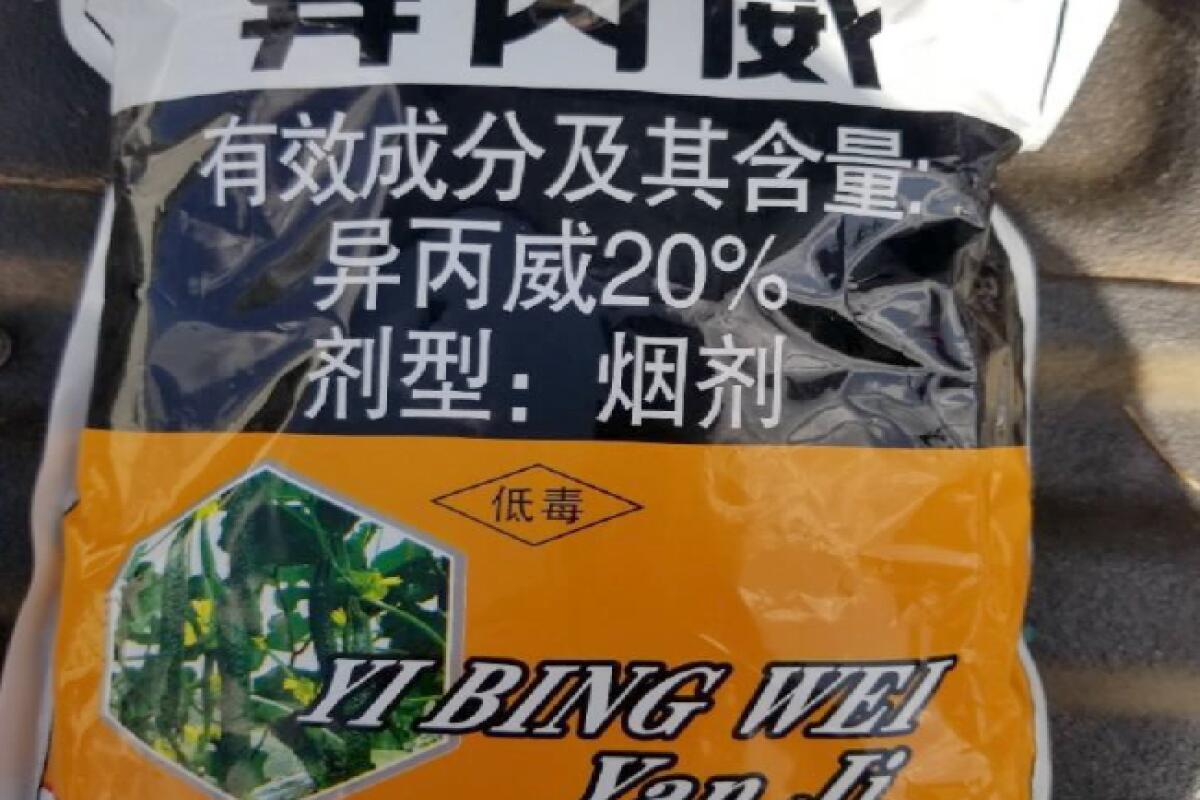
3
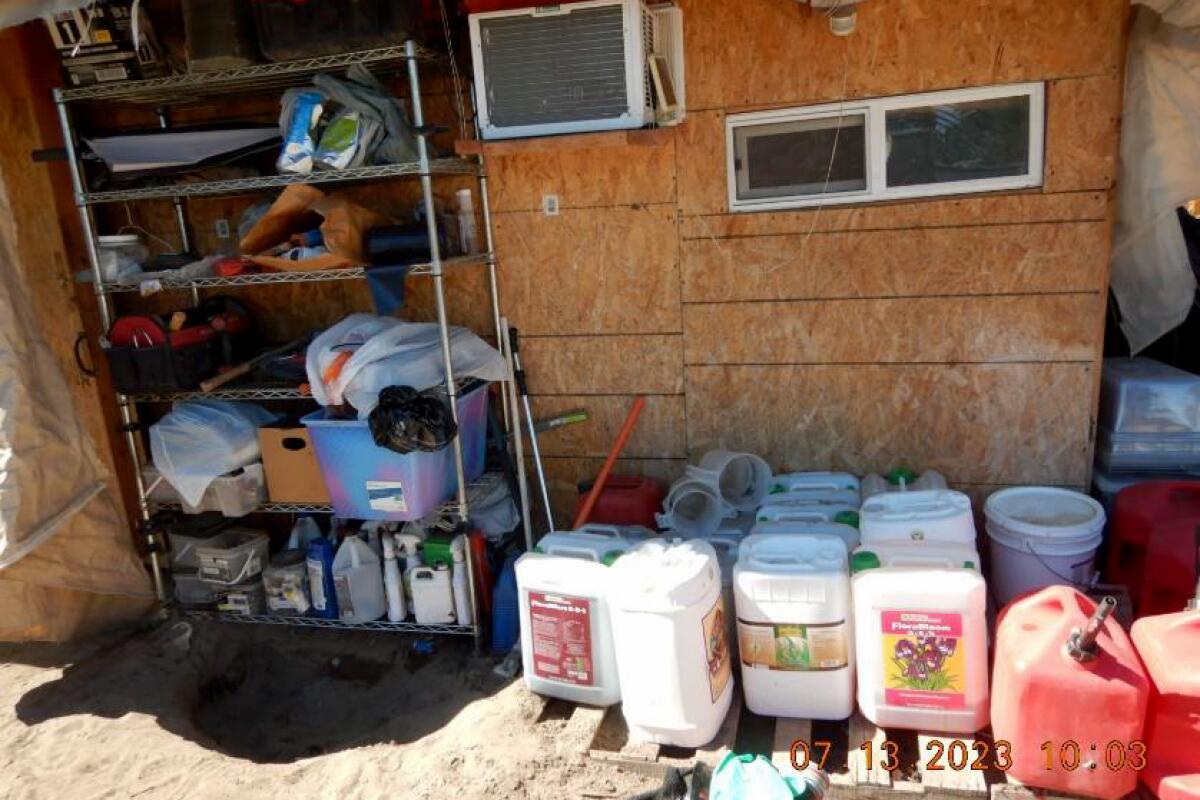
1. Opened mylar bags of illegal Chinese-label fumigants scatter the floor of a cannabis greenhouse in Siskiyou County. Lab tests identified 10 pesticides in the unbranded product, two potentially fatal if inhaled. (California Water Boards) 2. A Chinese fumigant containing isoprocarb, not approved for use in the United States, recovered from the Siskiyou County cannabis farm. (Integral Ecology Research Center) 3. Blue- and green-labeled unbranded pesticides sit on the top shelf, among other chemicals, at the farm. The Chinese-language products have prompted health warnings for law enforcement, but not cannabis consumers. (California Water Boards)
Interviews, confidential lab reports and public agency records also show a surge in pesticides smuggled from China that contain chemicals not permitted in the United States nor screened for in legal weed.
Cannabis growers tap into an outlaw market of banned, smuggled chemicals, putting public health at risk.
These unmonitored chemicals are so toxic California advised cannabis enforcement agents to wear hazmat suits and respirators during field inspections, and to undergo annual blood poisoning tests.

“Repeated inhalation of pesticide residues through regular smoking or vaping is quite concerning as this is a relatively direct route of exposure into the bloodstream,” said Kimberly Paul, an epidemiologist and assistant professor in neurology at UCLA who was lead researcher on the Central Valley study. “Low-level pesticide residues are something to be concerned about.”
National health surveys by the U.S. Substance Abuse and Mental Health Services Administration show those between ages 18 and 25 make up the largest part of the market: More than 40% of young adults used cannabis within the last year. Separate studies by the University of Michigan Institute for Social Research show 1 in 3 high school seniors last year used cannabis, two-thirds of them by vaping. Despite state laws against marketing to children, many brands reflect this youth appeal, from weed bags modeled after McDonald’s Happy Meals to vape flavorings that mimic bubblegum.
The risk for medical users
Pesticides, which are designed to kill living organisms, have their place in agriculture. Regulation is focused on limiting contact exposure to agriculture workers and residues lingering on fruits and vegetables at the market. Tolerances take into account the body’s ability to filter toxins through the liver.
Smoking and vaping, however, deliver chemicals directly to the lungs, into the blood and to the brain. The only other consumer product intended for smoking in this country is tobacco. Rather than demand pesticide inhalation studies for tobacco, the EPA decades ago decided smoking itself is so carcinogenic as to eclipse other health threats. The agency thus set a universal cap for tobacco contaminants at 0.01 part per million before requiring determination of health impacts, a standard California used to set limits for many chemicals in cannabis.
An illustrated explainer of how consuming weed that is contaminated with dangerous chemicals can have severe impacts on health including neurological damage, endocrine disruption, reproductive harm, loss of appetite, weakness and heart failure.
Arizona State University toxicologist Max Leung, who was part of the state team that in 2017 advised California cannabis regulators on pesticide risks, said the threats are greater for medical marijuana users who have epilepsy, Parkinson’s or other neurological disorders.
But Leung said the lack of federal recognition of cannabis’ widespread use, whether state-sanctioned or not, has left consumers vulnerable. There is a lack of data on health impacts experienced by cannabis users, though some states do solicit health complaints from the public, and in a few cases, those have led to product recalls for pesticides. California does not collect such information.
Rather than uniform national health standards, Leung and his team found a patchwork of disparate state regulations, different pesticides capped at different levels or not capped at all.
“You’ve got all of this contamination, but what do they do?” Leung said. “There’s just no research.”
- Share via
After passage of Proposition 64 created a legal recreational market in California, toxicologists with the Department of Pesticide Regulation proposed to ban from inhaled weed products 42 chemicals the agency said are harmful to people, the environment or water, according to a copy of the March 2017 proposal.
The limits were rejected amid industry concerns about testing costs and lab capacity.
Six months later, the pesticide agency returned with more relaxed rules. It cut the zero-tolerance list by half, to 21 chemicals, and set limits for 45 other pesticides on a par with tobacco standards. Manufacturers of products that failed screening can attempt to lower the pesticide levels — such as by dilution — or incorporate the weed into edibles, where higher levels are tolerated. If they fail again, according to state regulation, the batches must be destroyed.
Pesticide agency records, including interagency memos and emails, show that since 2018, despite repeated requests, cannabis regulators have not updated the list of chemicals that weed is tested for — even after pesticide regulators made a direct appeal to the governor’s cannabis advisor, Nicole Elliott. In January, the Department of Cannabis Control, which Elliot now heads, said it was working to update those regulations, but as of June no changes had been proposed.
State toxicologists have also been stymied from taking a more active role in protecting the public from cannabis pesticides.
California’s Department of Pesticide Regulation conducts some of the nation’s most sophisticated evaluation of pesticide exposure to the public. It even has an employee whose job title is “cannabis and hemp program manager.”
But when it comes to cannabis, a spokesperson for the pesticide agency said, responsibility for protecting consumers rests solely with the Department of Cannabis Control.
The pesticide regulators did try, early on, to draft their own public health advisories for cannabis, but those were never issued. The agency released copies of six under a public records request, and would not say how many more existed.
One of those advisories was for piperonyl butoxide contamination in cannabis. It was among the chemicals The Times and WeedWeek found in testing.
“Acute toxicity symptoms may include tearing, drooling, runny nose, congestion, and difficulty breathing,” the unreleased advisory read. It added that laboratory animals exposed to the pesticide had more miscarriages and produced offspring with fingers and toes that were sometimes fused.
In 2019, toxicologists in the Department of Pesticide Regulation tried but did not succeed in launching a program to monitor chemicals being used in the illicit market. Internal memos from 2021 show that those same toxicologists were barred from seeing data collected from product safety tests, making it impossible for them to monitor what was circulating in the legal market.

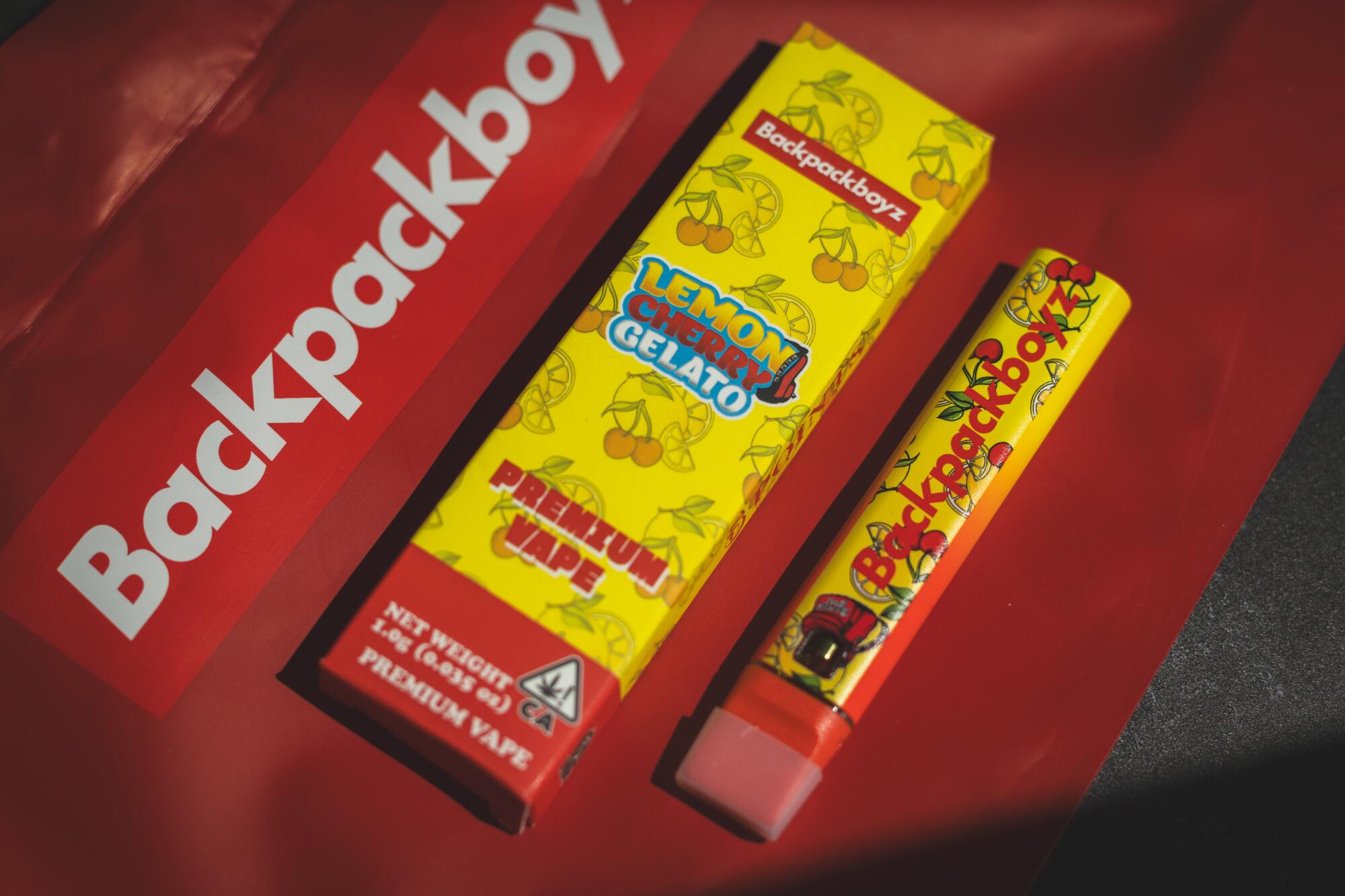
There is no easy way in California to trace contamination. The state does not investigate the sources of pesticides in cannabis goods, but instead relies on a system of paper trails — seed-to-sale inventories and lab testing certificates — to protect the public.
Tests for The Times and WeedWeek showed repeated contamination in small batches of vapes stamped with the unique tracking number of a Van Nuys manufacturer, David Shin.
Among them were Backpack Boyz carts with as many as two dozen pesticides, half of those above state safety limits and including chlorfenapyr, prohibited at any amount, at 2,000 times above the minimum detection level.
The bulk oil for these vapes originated from cannabis grown on a single Central Valley farm. Shin said he bought the oil through a broker and did no independent testing of his own.
He flavored and packaged the vapes and a state-certified lab declared the products pesticide-free. They were then distributed by a wholesaler to Backpack Boyz dispensaries across the state.
Alerted to the pesticides found by The Times and WeedWeek, Shin said he could not unravel the source of contamination. A manager for the wholesaler said the company was launching its own investigation. The owners of Backpack Boyz LLC, which holds no cannabis license, did not respond for comment.

The problem with cannabis trim
The THC oil that fills vape pens is extracted from biomass, plant material made up of lower potency leaves and stalks left after harvest, moldy flower and even high-quality buds that sit too long. Harsh chemicals and extreme temperatures in the extraction process can destroy a few pesticides, but most pesticides become more concentrated. That makes vapes more likely than select flowers to exceed safe limits.
The rise of intense cultivation practices — densely planted greenhouses and industrial warehouses with “sea of green” crops supported by netting — invites infestations of whiteflies, spider mites and mold. Clean cannabis can be commercially grown, but it requires time and care, said Sam Feliciano, a former pest control manager for a high-end Los Angeles brand, Maven Industries. It is cheaper and faster to douse high-value crops with chemicals, as Feliciano and other workers were ordered to do at Maven, they allege in a civil lawsuit.
An illustrated explainer of how chemicals used to control weed-killing pests make their way into cannabis products, and what producers can do when their products fail a lab test.
“I didn’t want to upset them and tell them, ‘No, it’s not OK to do that stuff,’” Feliciano said. “They simply would’ve just got rid of me.” Feliciano alleged in the civil suit that he suffered bouts of nausea, disorientation and confusion brought on by cannabis pesticide treatments. He told The Times that because of the impact to his health, he decided to quit. The workers in November were ordered to have their complaints heard by a private arbitrator.
By email, Maven Industries Chief Executive David Bosworth declined to comment on the lawsuit but asserted the company’s products “are certified as safe and are, in fact, safe for consumer use.”
Legalization has also brought large-scale cultivation out of the mountains and into agricultural areas, including Central Valley farmlands, where airborne pesticides drift from almond groves and grape vineyards.
At the same time, the explosion in vape sales has created heavy demand for distillate. California vape sales tripled from 2020 to 2023 to become a $1.4-billion market, and now only slightly trail those of packaged flower.
To feed this demand, bulk oil manufacturers seek out lower-quality weed, much of it contaminated, to buy at discounted rates.
To meet state screening limits, the extracted oils, or distillates, are blended to dilute pesticides.
One manufacturer who solicits farmers for “dirty” weed defended the practice, saying he provided struggling growers an income source while keeping otherwise unusable cannabis out of the landfill.
The amber-colored bulk oil moves on an opaque market, traded by brokers who operate without license or regulation. It is bought by manufacturers who sometimes will use oil from the same batches to fill thousands of vape cartridges for competing brands.
This cheap commodity oil now dominates the market, selling for a fraction of the cost to produce a clean product.
The cannabis industry’s reliance on low-quality weed enrages old-style farmers such as Mary Gaterud, who nurtures her sun-grown plants on a Humboldt County farmstead that has been her principal means of support for decades.
She is offended by the pleas she regularly receives from those seeking “old, moldy or even dirty trim,” as a San Luis Obispo distributor put it in a text to her in February.
A Humboldt buyer, with “Turn That Trash into Cash” in the subject line, asked for “trim with all levels of pesticides and heavy metals.”
“The people who are doing it right get crushed,” she said. “The bad actors are encouraged and rewarded. And the consumers are poisoned while being told they are safe.”

The Weed Whistleblowers
In February 2022 a group of California cannabis testing labs, upset about what they believed was widespread fraud in weed potency claims, decided to force regulators into action.
They formed a blind round robin, each lab testing retail flower samples without knowing whose work they were checking. In the course of testing for potency, one batch of flower was found to contain three times the allowed level of pyrethrins.
Cannabis regulators were alerted but issued no recall. In fact, it wasn’t until the end of 2023, six years after recreational sales became legal, that California sought to remove a product for pesticide contamination, according to the agency’s published recalls.
When cannabis was first legalized, labs rushed to be licensed to capitalize on the expanding market. But labs with stringent testing methods and expensive equipment complained to the state of losing customers to operators that promised high potency results or had track records for approving most products.
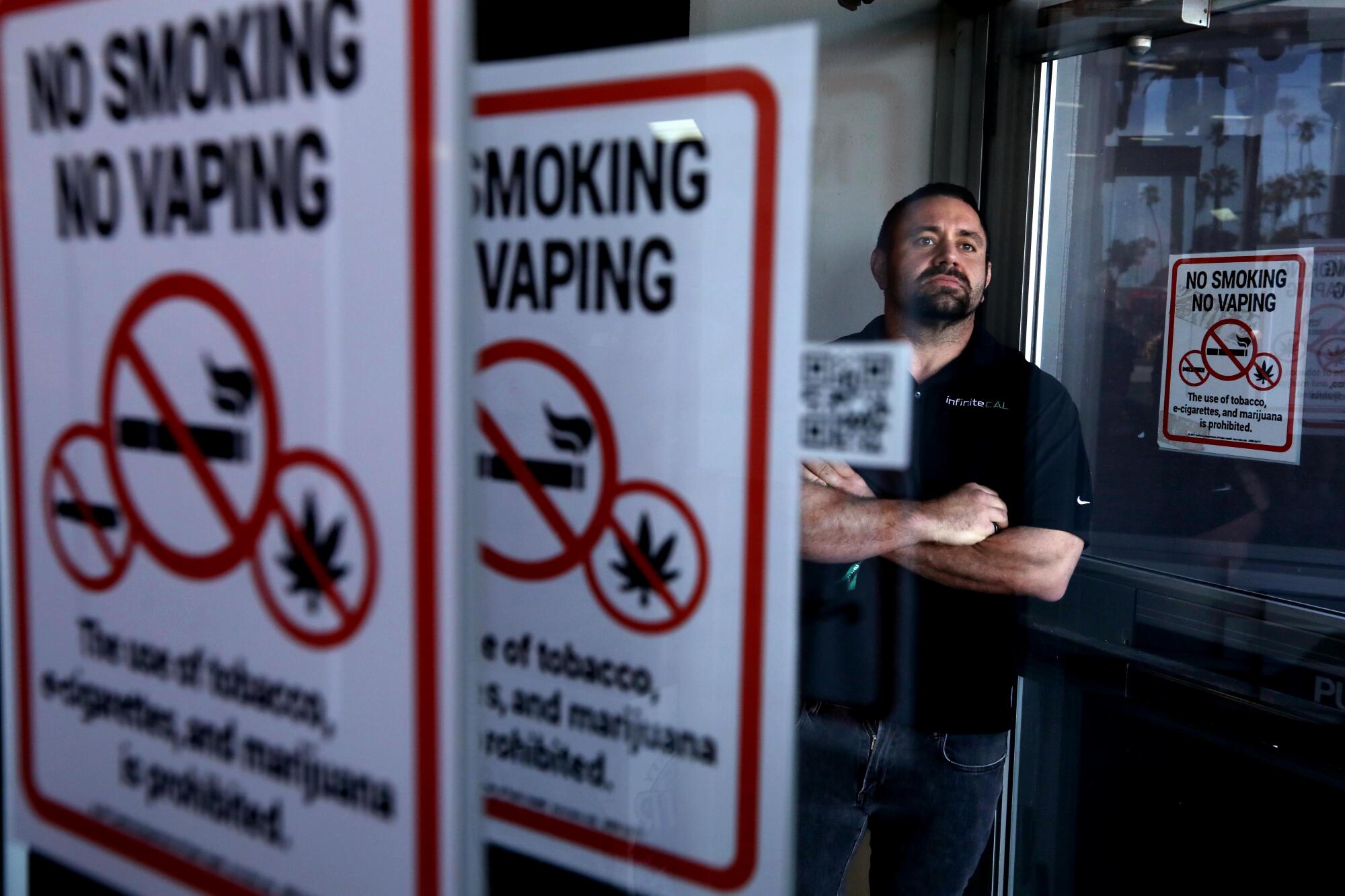
“There’s no checks and balances ... to make sure no one’s doing something wrong when they’re not being watched,” said Swider, of Infinite Chemical Analysis Labs. “That’s all we’ve ever asked for.
“I don’t want to be the judge, jury and executioner. I just wanna let everyone be treated fairly.”
Swider embarked on doing what regulators were not — testing weed specifically for pesticides.
He ultimately sent cannabis regulators 77 complaints about pesticide contamination he found in tests conducted from last October to May.
The complaints included Zoap flower sold by Grizzly Peak Farms and Cru Mai Tai vape carts, both with chlorfenapyr, prohibited at any detectable level; Fog City Farms Shark Bites with too much piperonyl butoxide and spiromesifen; West Coast Cure Biscotti vapes with myclobutanil, and Jack Herer-flavored ones with chlorfenapyr, paclobutrazol, bifenazate and trifloxystrobin. Backpack Boyz vapes contained chlorfenapyr, bifenazate, bifenthrin, etoxazole, malathion, myclobutanil, piperonyl butoxide, pyrethrins and spiromesifen. Most of the manufactures told reporters they were unaware of contamination because their product had been certified as safe by private labs.
It took 41 days from receiving Swider’s complaint for regulators to announce California’s first-ever pesticide recall of a cannabis product, the Zoap flower sold by Grizzly Peak Farms. The lab that had cleared the product for market, ProForma Labs, also lost its license. But regulators took no action against those who grew the weed, a cultivation arm of the Kolas brand. Tests for The Times and WeedWeek showed Zoap sold under a Kolas label also contained chlorfenapyr.
Kevin McCarty, an owner of Sacramento-based Kings Holdings, which grew the Zoap strain, said no zero-tolerance pesticides were used in its cultivation and the cannabis had been certified by state-licensed labs. The Department of Cannabis Control “has not initiated any additional recalls involving us, and we have no additional comment,” McCarty wrote by email.
The Department of Cannabis Control’s second pesticide recall came in January, eight weeks after Swider’s tipoff. The affected Fog City pre-rolls were nearly sold out by the time the public was alerted in January.
Four flavors of Phat Panda vapes also were voluntarily removed from sale, for what regulators told consumers was a labeling mistake — despite outside tests that showed dangerous levels of malathion. California has issued no pesticide warnings since.
Swider’s tests found that 19 varieties of vapes by California’s fourth-largest brand, West Coast Cure, carried a large assortment of illegal pesticide loads. After learning of those results, operators of a San Francisco-based lab, Anresco, undertook their own tests and also notified California regulators of pesticides in eight West Coast Cure products.
Sarah Otis, Anresco’s director of quality assurance, said regulators asked for reams of supporting data, then refused to say whether they would act on the information. “Now that we know there’s contaminated product on the market, like what, what do we do with that?” she said.
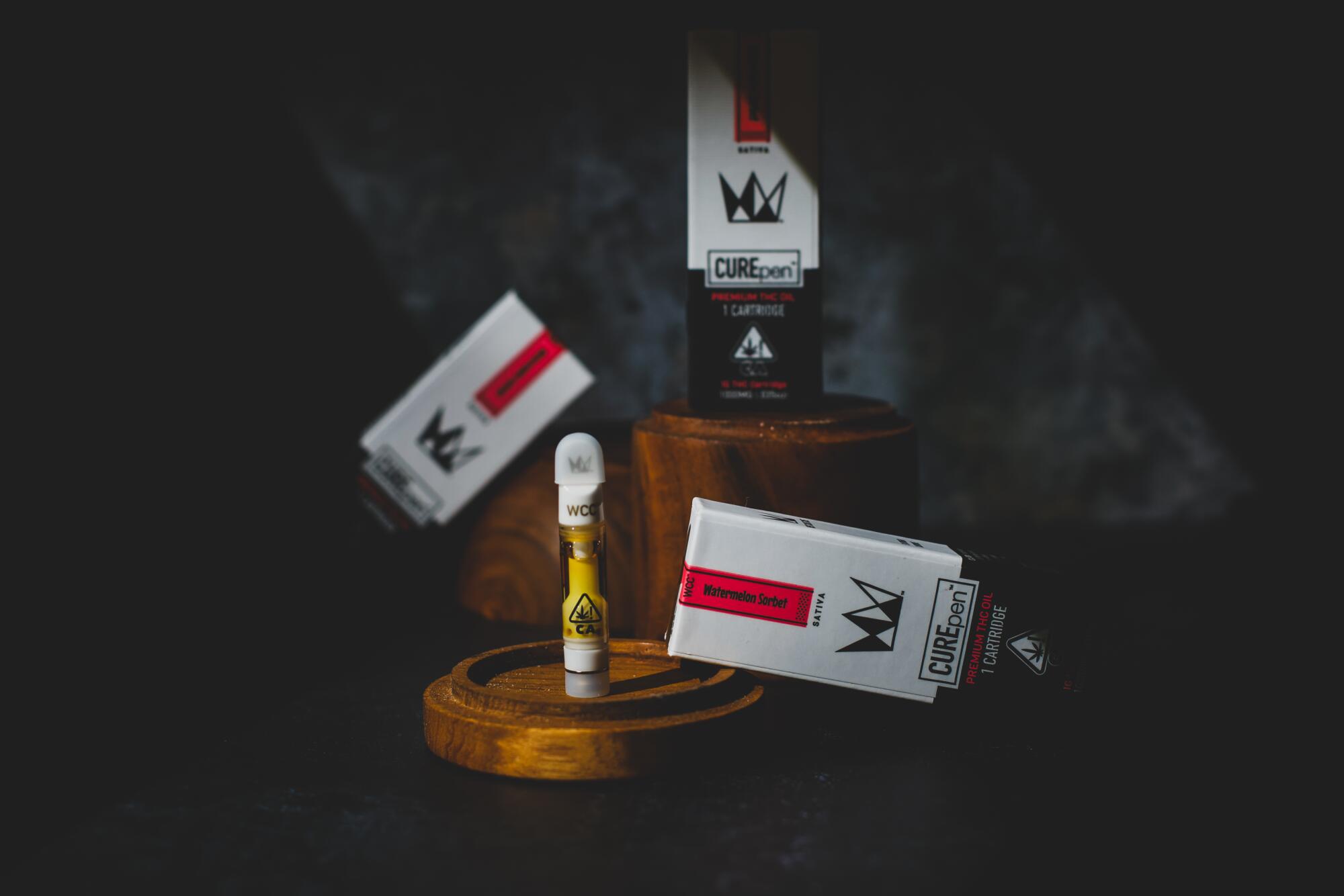
Anresco also agreed to test products for The Times and WeedWeek, as did a Santa Cruz-based cannabis testing company, SC Labs. Reporters bought products from dispensaries across the state, choosing some that were the subject of complaints and others at random. The results confirmed Swider’s findings and identified additional contaminated products. Some goods violated state limits for a single chemical. Others, such as vapes by West Coast Cure and Backpack Boyz, contained dozens of undisclosed pesticides.
California doesn’t pull legal weed from store shelves to test for pesticides; we did and found dangerous chemicals
Manufacturers universally defended their products and cast doubt on the lab testing industry.
“We’ve invested millions of dollars to build our business in compliance with California’s laws and regulations. We firmly advocate for the stringent testing mandated by the state to guarantee the safety and excellence of our products,” said Logan Wasserman, the CEO of West Coast Cure’s parent company, Shield Management Group. He contended that responsibility for ensuring product safety was on the labs that declared his vapes pesticide-free.
The Department of Cannabis Control issued no public recalls of West Coast Cure products, but did conduct a surprise inspection at its Long Beach facility. In early May, the agency levied a $3.2-million fine against Wasserman’s company, saying it failed to guard against product tampering, including storing goods in the parking lot in shipping containers that had no security cameras. It was also cited for failing to provide legally required video proving the selection of product samples for lab testing was not rigged.
Wasserman did not respond to questions about the citations.
Directors of labs that had certified products cited as contaminated in Swider’s crusade accused him of seeking a competitive edge, even spiking pesticides into clean samples. They accused clients of having clean material tested and sending contaminated goods to market. None made these statements on the record. They cited fear of lost business, litigation and personal harm.
They also said pesticide testing is inexact, and easily manipulated.
“You could give it to 10 different labs and get 10 different results,” said Paul Hamrah, owner of Verity Analytics, the San Diego lab that approved vapes by West Coast Cure, Phat Panda and Maven that subsequently showed pesticides. Hamrah asserted that those testing products for The Times and WeedWeek tampered with the results as part of “an elaborate smear campaign.”
The labs denied the allegation.
State inspectors visited Hamrah’s lab in January, “trying to shut us down because of cases made against us by Infinite,” Hamrah said. In late April the state suspended Verity Analytics’ license, saying the lab “has engaged in activity that poses harm to public health, safety or welfare.”
The suspension — reviewed by The Times and WeedWeek — said Verity inflated potency of four cannabis products, failed to show accreditation, could not provide the chemical standards it used to check calibration and told regulators it had “unacceptable” accuracy ratings for testing pesticides, molds and solvents. Inspectors also said Verity labeled a pesticide as “non detect” when equipment showed contamination, without offering “any scientific criteria.”
Hamrah said what inspectors took to be a pesticide hit was instead “instrument noise.”
“I am determined to prove my lab is a victim of a grand and elaborate frame job by several labs because they couldn’t compete with us,” he said. “We were expanding and they got scared.”
Meanwhile, Swider became a target. He said he lost clients as word of his activism spread. Then while traveling in March, Swider received a cellphone call from a blocked number.
“I’m going to come and get you and your ... whole family,” the caller said. “You’re gonna pay for this.”
“It makes me want him to get out” of the cannabis industry, said his wife, Kaylena Swider. “He’s like, ‘What would I do?’”
In late May, Swider filed one more round of complaints with the Department of Cannabis Control, alerting the agency to excessive pesticides in 16 products, some of them subject of prior complaints but still for sale.
Days later, he received an email from the agency.
It was sending inspectors to audit his lab.

Cannabis regulators
California’s Business and Professions Code 26011.5 is explicit about the mission of the state cannabis regulatory agency: “The protection of the public shall be the highest priority. … Whenever the protection of the public is inconsistent with other interests sought to be promoted, the protection of the public shall be paramount.”
In industry presentations, Elliot, the Department of Cannabis Control director, often identifies the challenges facing California cannabis as economic.
Chief among her concerns, she told the National Cannabis Industry Assn. in February, is the large swath of California that prohibits dispensaries. These “cannabis deserts,” as Elliott calls them, are the greatest constraint to “scalability,” or expansion, of California’s legal market.
To drive business to licensed dispensaries, Elliott’s agency conceived the Real CA Cannabis campaign.
“We know we have a good amount of consumption from the illegal market. We know there’s an opportunity through education to shift some behavior to the legal market,” Elliott told the trade group.
The social media campaign, launched in February, included ads targeted at seniors, among others, because polling showed they were most swayed by safety messages.
The catchphrases promoting legal weed include “the good stuff” and “quality you can trust.”
The belief that any cannabis product carrying a certificate of analysis, or COA, is safe is foundational for dispensary owners.
“We will not accept it [for sale] if it doesn’t have a COA,” said Dave Sisson, a board member of Foothills Health and Wellness, a legacy dispensary that over two decades has earned the trust of medical providers who send cancer patients to the store in Shingle Springs, east of Sacramento.
To learn some of these certified products carry pesticides, Sisson said, “is absolutely terrible.”
“These are medically compromised people. They have to be very, very careful of what they put into their body.”
“As a retailer, I’m sitting in this really strange position where everything comes to me ‘safe and tested,’” said the owner of a multicounty dispensary chain, speaking anonymously because of concern of being tied to bad publicity for the struggling legal industry. “But it’s so crazy that we’re operating in a system where” many are “gaming it.”
Elliott declined to be interviewed on the extent of the pesticide threat. Her agency selectively responded to requests for public records, and refused to release records regarding policies on pesticide contamination. It contended that it conducts random testing of products for sale to consumers.
Behind the scenes, internal records showed, the cannabis agency as early as late February sent buyers into the field to obtain products on Swider’s lists. They remained stockpiled for months while the department worked to get its Richmond lab — able only to test potency and check for mold — accredited to run pesticide screens. As of early June, accreditation records showed the lab was still not ready, and most of the products flagged for contamination had sold out. On Monday, a spokesperson said the regulatory agency would be able to begin tests on consumer products collected from store shelves by the following week.
Other agencies in the Newsom administration also refused to release cannabis-related records. The Department of Fish and Wildlife provided partial summaries but no records of pesticides encountered by its agents on raids. The Department of Toxic Substances Control said its reports on pesticides encountered on cannabis sites were confidential. The Department of Pesticide Regulation over eight months released only partial records that hinted at the extensive work its staff had undertaken to address pesticide-tainted weed.
Department of Cannabis Control employees, who spoke on condition of anonymity, complained of a lack of willingness within the agency to take a hard line on pesticide contamination. One said she was schooled on the importance of “not disrupting the market.”
In January, as The Times and WeedWeek began asking questions regarding its handling of licensed cannabis products, the agency launched a series of product recalls — not for pesticides, but for mold and misleading potency claims.
The department also asked the Legislature for an $8.2-million budget increase, seeking to hire more enforcement lawyers and laboratory staff to develop testing protocols.
Within 48 hours of being provided the findings of this story for response, the deputy director of lab services left. No public reason for the departure was given.
A day later, speaking to the National Cannabis Industry Assn., Elliott emphasized her concern for public health.
“My road map isn’t about preserving what is. It’s about creating what is best for consumers, for the general public,” she said. “That’s sort of my North Star.”
How dirty is your weed
Alex Halperin is editor of the industry newsletter WeedWeek.
Times staff writer Adam Elmahrek contributed to this report.
More to Read
Sign up for This Evening's Big Stories
Catch up on the day with the 7 biggest L.A. Times stories in your inbox every weekday evening.
You may occasionally receive promotional content from the Los Angeles Times.

